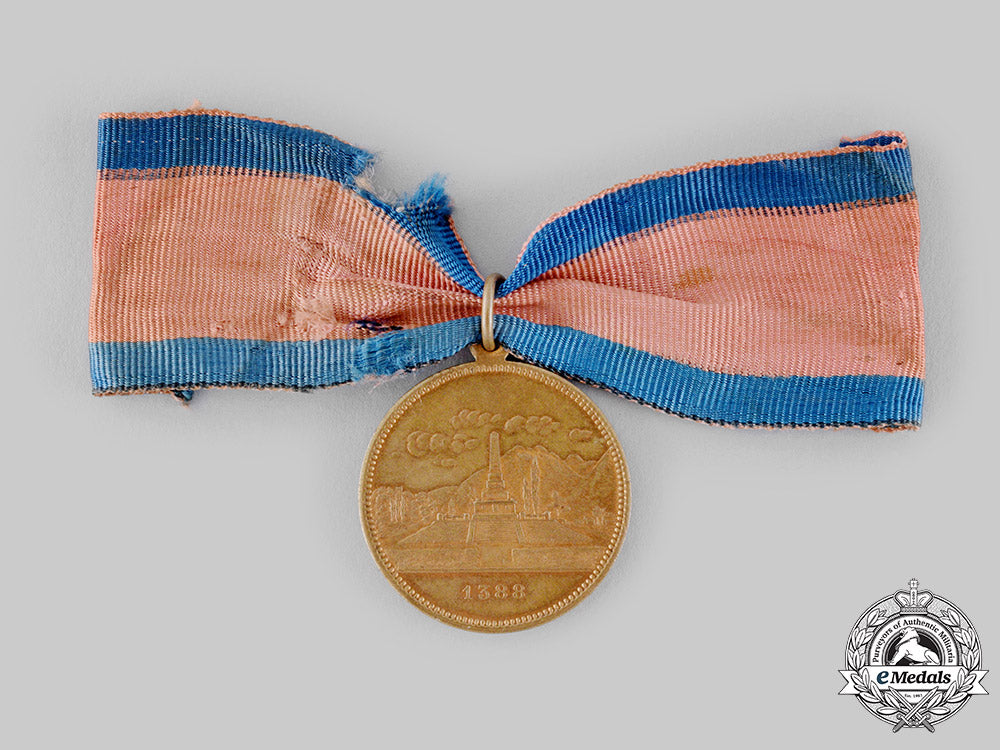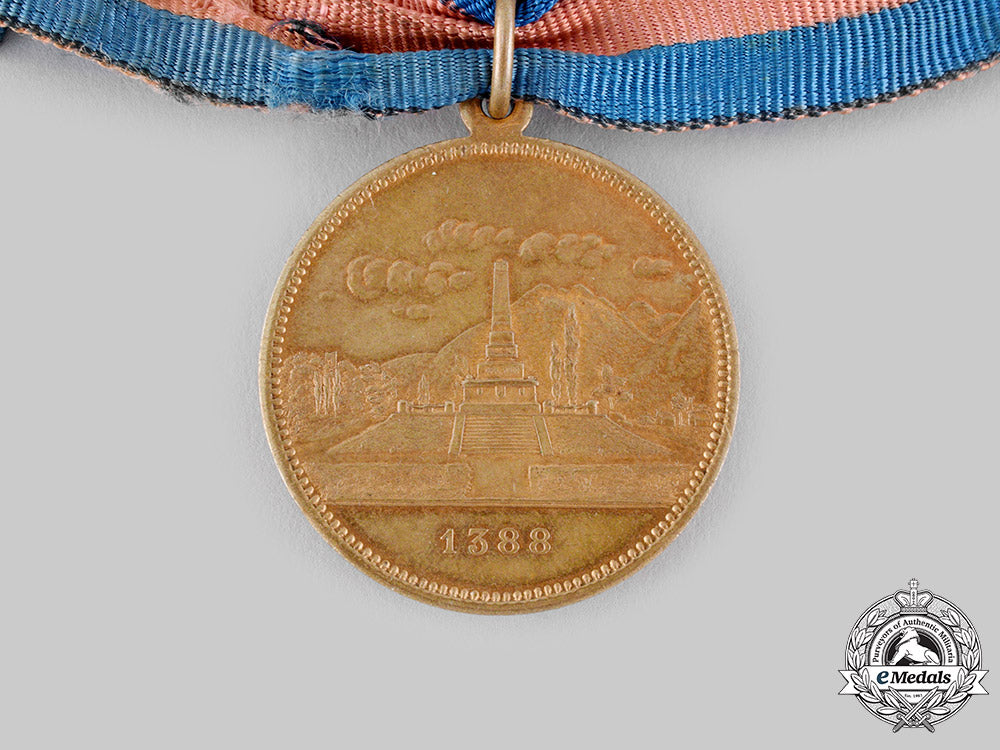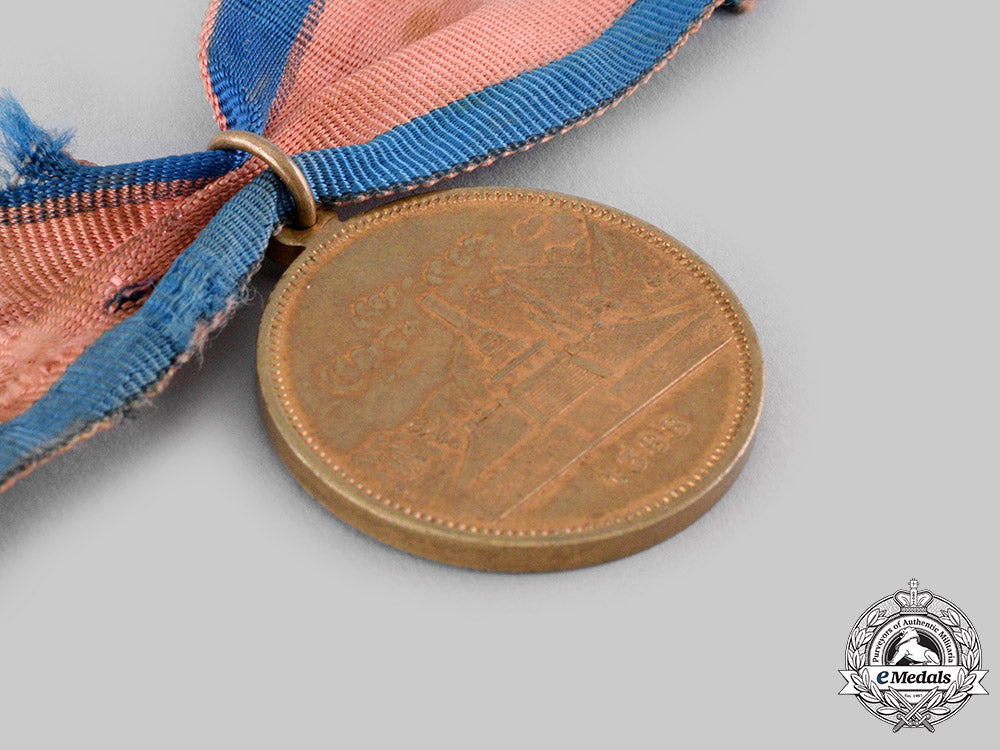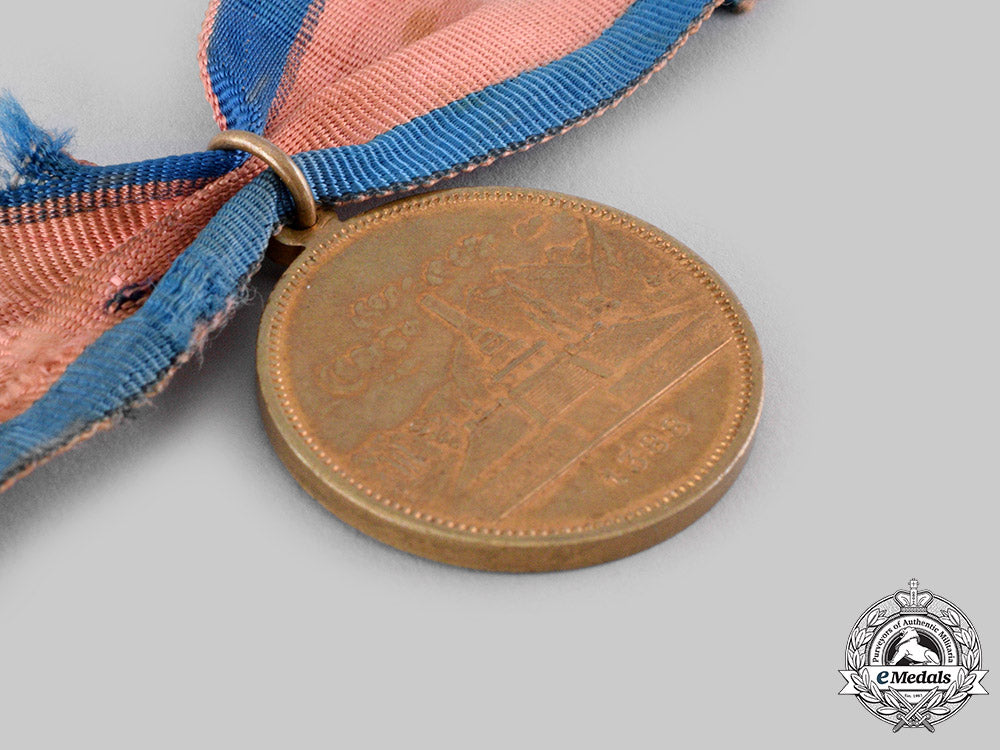
LOADING ...
In response to evolving domestic opinion, eMedals Inc has made the conscious decision to remove the presentation of German Third Reich historical artifacts from our online catalogue. For three decades, eMedals Inc has made an effort to preserve history in all its forms. As historians and researchers, we have managed sensitive articles and materials with the greatest of care and respect for their past and present social context. We acknowledge the growing sentiments put forth by the Canadian public and have taken proactive actions to address this opinion.




Switzerland, Federal State. A Medal For The 500Th Anniversary Of The Battle Of Näfels 1388-1888
Switzerland, Federal State. A Medal For The 500Th Anniversary Of The Battle Of Näfels 1388-1888
SKU: ITEM: EU17226
Current Bid:
Your Max Bid:
Bid History:
Time Remaining:
Couldn't load pickup availability
Shipping Details
Shipping Details
eMedals offers rapid domestic and international shipping. Orders received prior to 12:00pm (EST) will be shipped on the same business day.* Orders placed on Canadian Federal holidays will be dispatched the subsequent business day. Courier tracking numbers are provided for all shipments. All items purchased from eMedals can be returned for a full monetary refund or merchandise credit, providing the criteria presented in our Terms & Conditions are met. *Please note that the addition of a COA may impact dispatch time.
Shipping Details
eMedals offers rapid domestic and international shipping. Orders received prior to 12:00pm (EST) will be shipped on the same business day.* Orders placed on Canadian Federal holidays will be dispatched the subsequent business day. Courier tracking numbers are provided for all shipments. All items purchased from eMedals can be returned for a full monetary refund or merchandise credit, providing the criteria presented in our Terms & Conditions are met. *Please note that the addition of a COA may impact dispatch time.
Description
Description
In bronze gilt, obverse illustrating the Battle of Näfels monument with the date "1388" below, within a reeded border, reverse inscribed "ERINNERUNG AN DIE 500 JÄHRIGE JUBILÄUMSFEIER DER SCHLACHT BEI NÄFELS 5.-6. APRIL 1888", framed by a wreath composed of oak leaves with the Swiss shield at the top of the wreath, within a reeded border, measuring 33.5 mm in diameter, scattered gilt wear, light contact, original ribbon, better than very fine.
Footnote: The Battle of Näfels was fought on April 9, 1388 between Glarus with its allies the Old Swiss Confederation, and the Habsburgs. It was a decisive Glarner victory despite being outnumbered sixteen to one. The Battle of Näfels was the last battle of the Swiss-Austrian conflicts that stretched through most of the 14th Century. A few weeks after the Battle of Sempach on July 9, 1386, the Old Swiss Confederation attacked and besieged the Habsburg village of Weesen on the Walensee. The following year, Glarus rose up against the Habsburgs and destroyed Burg Windegg. Then, on March 11, 1387, the valley council declared itself free of Habsburg control. In response, on the night of February 21-22, 1388, an Austrian army attacked the village of Weesen and drove off the Swiss forces. At the beginning of April, two Austrian armies marched out to cut off Glarus from the rest of the Confederation. The main army, with about 5,000 men, marched toward Näfels under the command of the Graf Donat von Toggenburg and the Knight Peter von Thorberg. A second column, with about 1,500 men under the command of Graf Hans von Werdenberg-Sargans, marched over the Kerenzerberg Pass. On April 9, 1388 the main army, under Toggenburg and Thorberg, attacked and captured the wall across the valley (Letzi) around Näfels. The garrison, comprising about 400 Glarner troops and a few dozen troops from both Schwyz and Uri, held out for a short time, but was forced to withdraw into the hills. As they retired, the Austrian army spread out to plunder the villages and farms. The Glarners now emerged from the snow and fog to take the Austrians by surprise as they were preoccupied with looting. Following a brief battle, the disorganized Austrians broke and fled toward Weesen, but the collapse of the bridge over the Maagor Weeser Linth dropped much of their army into the river where they drowned.
Seeing the destruction of the main column, Werdenberg-Sargans' army retreated to the village of Beglingen (now in the municipality of Mollis). The Glarner and Confederation army suffered 54 men killed, who were buried at the parish church of Mollis. Habsburg losses are less well known, though are estimated to be between several hundred killed and 1,700. On November 29, 1389, the Abbot Bilgeri had about 180 bodies moved from the battlefield and reburied at Rüti Abbey in the choir of the present Rüti Reformed Church. In 1389, a seven-years' peace was signed at Vienna, leaving the Confederation in undisputed possession of all the territory it had acquired in the recent war. In the same year, the first Näfelser Fahrt, a pilgrimage to the site of the battle was held. This pilgrimage, which still occurs, happens on the first Thursday in April and is in memory of the battle. The pilgrimage played an important role in the creation of the unified canton of Glarus.
Description
In bronze gilt, obverse illustrating the Battle of Näfels monument with the date "1388" below, within a reeded border, reverse inscribed "ERINNERUNG AN DIE 500 JÄHRIGE JUBILÄUMSFEIER DER SCHLACHT BEI NÄFELS 5.-6. APRIL 1888", framed by a wreath composed of oak leaves with the Swiss shield at the top of the wreath, within a reeded border, measuring 33.5 mm in diameter, scattered gilt wear, light contact, original ribbon, better than very fine.
Footnote: The Battle of Näfels was fought on April 9, 1388 between Glarus with its allies the Old Swiss Confederation, and the Habsburgs. It was a decisive Glarner victory despite being outnumbered sixteen to one. The Battle of Näfels was the last battle of the Swiss-Austrian conflicts that stretched through most of the 14th Century. A few weeks after the Battle of Sempach on July 9, 1386, the Old Swiss Confederation attacked and besieged the Habsburg village of Weesen on the Walensee. The following year, Glarus rose up against the Habsburgs and destroyed Burg Windegg. Then, on March 11, 1387, the valley council declared itself free of Habsburg control. In response, on the night of February 21-22, 1388, an Austrian army attacked the village of Weesen and drove off the Swiss forces. At the beginning of April, two Austrian armies marched out to cut off Glarus from the rest of the Confederation. The main army, with about 5,000 men, marched toward Näfels under the command of the Graf Donat von Toggenburg and the Knight Peter von Thorberg. A second column, with about 1,500 men under the command of Graf Hans von Werdenberg-Sargans, marched over the Kerenzerberg Pass. On April 9, 1388 the main army, under Toggenburg and Thorberg, attacked and captured the wall across the valley (Letzi) around Näfels. The garrison, comprising about 400 Glarner troops and a few dozen troops from both Schwyz and Uri, held out for a short time, but was forced to withdraw into the hills. As they retired, the Austrian army spread out to plunder the villages and farms. The Glarners now emerged from the snow and fog to take the Austrians by surprise as they were preoccupied with looting. Following a brief battle, the disorganized Austrians broke and fled toward Weesen, but the collapse of the bridge over the Maagor Weeser Linth dropped much of their army into the river where they drowned.
Seeing the destruction of the main column, Werdenberg-Sargans' army retreated to the village of Beglingen (now in the municipality of Mollis). The Glarner and Confederation army suffered 54 men killed, who were buried at the parish church of Mollis. Habsburg losses are less well known, though are estimated to be between several hundred killed and 1,700. On November 29, 1389, the Abbot Bilgeri had about 180 bodies moved from the battlefield and reburied at Rüti Abbey in the choir of the present Rüti Reformed Church. In 1389, a seven-years' peace was signed at Vienna, leaving the Confederation in undisputed possession of all the territory it had acquired in the recent war. In the same year, the first Näfelser Fahrt, a pilgrimage to the site of the battle was held. This pilgrimage, which still occurs, happens on the first Thursday in April and is in memory of the battle. The pilgrimage played an important role in the creation of the unified canton of Glarus.




You May Also Like
Germany, Third Reich. A Mixed Lot of Tyrolean Marksmanship Badges
G52930
Germany, SS. An Estonian Waffen-SS Volunteer’s Sleeve Shield
G50381
Germany, OT. An Organisation Todt Security Command Member’s Cuff Title
G50408
Germany, SS. A Waffen-SS Sturmmann Sleeve Insignia
G52846
Germany, Third Reich; Slovakia, First Republic. A Mixed Lot of Wartime Postcards
G52905
-
Germany, Third Reich. A Mixed Lot of Tyrolean Marksmanship Badges
G52930
Add to CartRegular price $135 USDRegular price $0 USD Sale price $135 USDUnit price / per -
Germany, SS. An Estonian Waffen-SS Volunteer’s Sleeve Shield
G50381
Add to CartRegular price $150 USDRegular price $0 USD Sale price $150 USDUnit price / per -
Germany, OT. An Organisation Todt Security Command Member’s Cuff Title
G50408
Add to CartRegular price $135 USDRegular price $0 USD Sale price $135 USDUnit price / per -
Germany, SS. A Waffen-SS Sturmmann Sleeve Insignia
G52846
Add to CartRegular price $135 USDRegular price $0 USD Sale price $135 USDUnit price / per -
Germany, Third Reich; Slovakia, First Republic. A Mixed Lot of Wartime Postcards
G52905
Add to CartRegular price $135 USDRegular price $0 USD Sale price $135 USDUnit price / per
Do you have a similar item you are interested in selling?
Please complete the form and our client care representatives will contact you.
Sell Item












